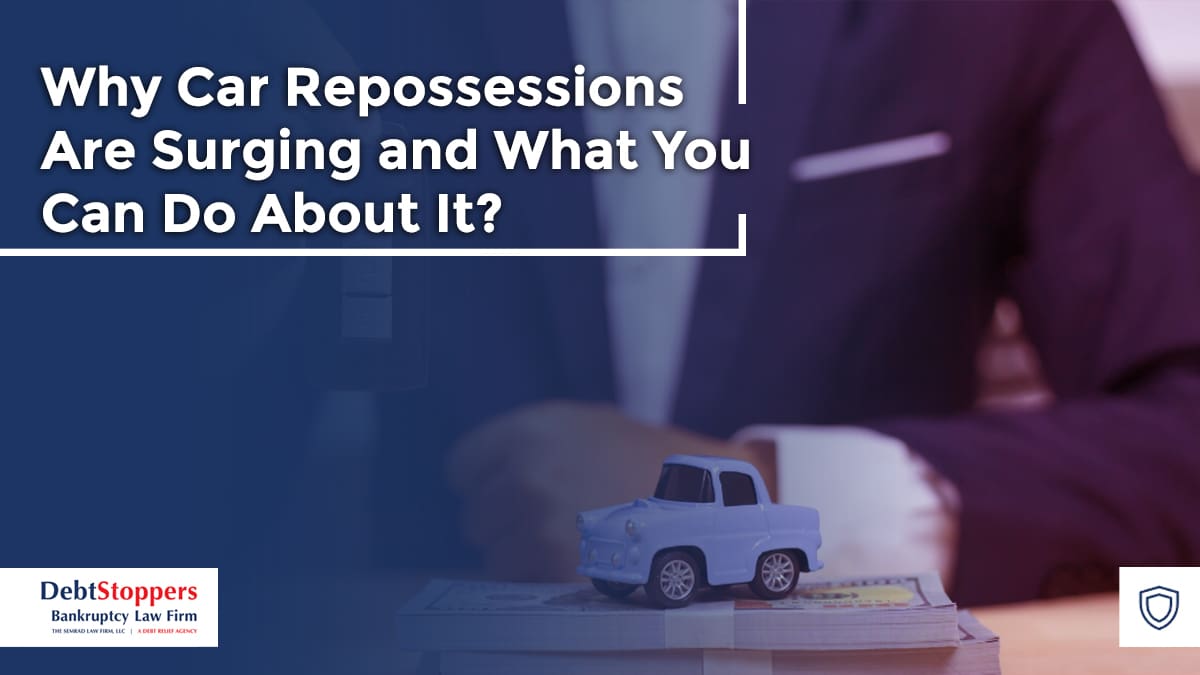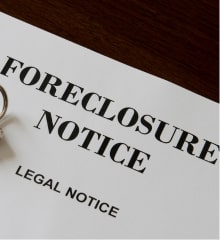Why Car Repossessions Are Surging and What You Can Do About It?
Updated on 06 November 2025

Car repossessions are on the rise across the United States, leaving many drivers without reliable transportation and facing the fallout of damaged credit and mounting debt. For families already struggling to keep up with rising prices, job instability, or medical expenses, the loss of a vehicle can feel like a devastating blow, especially when it disrupts daily life, employment, or access to childcare and healthcare.
It’s important to understand that the recent spike in auto loan defaults and repossessions reflects the current economic climate and the broader financial pressures affecting millions of households across America. As inflation, interest rates, and loan defaults continue to rise, more borrowers are falling behind on their auto payments, and lenders are acting quickly.
Understanding what car repossession is, how the process works in your state, and what steps you can take to prevent or recover from repossession can help you protect your vehicle and everything that depends on your ability to get around.
What is Car Repossession?
Car repossession refers to the legal process that allows a lender to take back possession of a vehicle because the borrower has defaulted on the auto loan. Most loan agreements allow for repossession without a court order, especially in states like Georgia and Texas, where the process can happen very quickly.
Repossession doesn't only apply to missed payments. A borrower may also be in default if they fail to maintain insurance or violate other terms of the loan. Once a vehicle is repossessed, the lender typically sells it at auction and applies the proceeds to the outstanding loan balance. It’s important to know that if the sale doesn’t cover the full amount owed to the lender, the borrower may still be responsible for the deficiency balance, along with repossession and storage fees.
People are often surprised to find out that lenders are not always required to notify you before repossessing your vehicle. Once you miss a payment or violate the terms of the loan, repossession can occur without warning. However, it’s important to know that you do have rights. For example, even if a repossession does not require court involvement, the repossession agent is not allowed to breach the peace by using force or breaking into a locked garage.
What Happens After Your Car Gets Repossessed?
If your vehicle has been repossessed, the lender is required to notify you of the next steps. This usually includes a written notice of sale, explaining whether the lender intends to sell the vehicle at auction or through a private sale, along with the amount you must pay to reclaim it.
This this point, you will have the option to reinstate the loan, which means paying the past-due amount, plus fees, to bring the loan current and recover the vehicle. You will also have the option to redeem the vehicle by paying the full remaining balance of the loan, plus fees, which is not usually financially feasible for many borrowers.
If you do not take any action, the lender will move forward with the sale of the vehicle. If the proceeds from the sale are not enough to cover your loan, you may be responsible for the deficiency balance. Failure to pay the remainder can result in lawsuits, wage garnishment, or additional collection actions.
Repossession also negatively impacts your credit score, typically by 100 points or more. Additionally, the repossession will remain on your credit history for up to seven years, making it harder to qualify for loans, leases, or even certain jobs.
When should you hire a vehicle repossession lawyer to stop or reverse the process?
Most people wait too long before calling a vehicle repossession lawyer.
By the time the tow truck shows up, their options are limited.
The truth is, the moment you realize you might miss a car payment, that’s the right time to get legal advice.
Acting early can change everything.
We’ve seen this happen countless times. Someone ignores the calls, hoping things will sort themselves out,
and suddenly the car is gone overnight. Every state has its own vehicle repossession laws,
and a good repossession lawyer knows exactly what lenders can and can’t do.
For example, your lender might have the right to take the car, but they can’t break into your locked garage
or cause a public disturbance. Those are clear violations of your car repossession rights.
If you’re wondering, “Can bankruptcy stop repossession of vehicle?” — yes, it can.
Filing for Chapter 13 bankruptcy immediately triggers a legal protection called the automatic stay,
which stops repossession in its tracks. We’ve filed cases for clients the same day their car was scheduled
for pickup, and saved it.
The sooner you talk to a vehicle repossession lawyer, the more power you have.
Don’t wait for that knock on the door. A quick consultation could be the difference
between losing your car and keeping your life on track.
What questions should you ask before hiring a repossession lawyer for your case?
Hiring a repossession lawyer is about trust. You’re putting your financial future in their hands,
so it’s worth asking the right questions. Start with experience: How many vehicle repossession cases
have you handled? You’d be surprised how different repossession law can be from one state to another.
A lawyer who knows vehicle repossession laws by state can help you navigate local rules and lender tactics.
You should also ask about their approach. Some lawyers focus on negotiation, others on court action,
and some specialize in bankruptcy. Ask them to walk you through what happens after your car gets repossessed
and how long does the repossession process take. The right attorney will explain each step, not rush you through it.
We always tell clients: ask about communication. How often will they update you?
How quickly will they respond to your calls? A reliable vehicle repossession lawyer
will be upfront about timelines, costs, and outcomes.
If you feel brushed off or confused, that’s a sign to keep looking.
Remember, the right repossession lawyer doesn’t just fight for your car — they fight for your peace of mind.
How to fix credit after a car repossession and rebuild financial stability?
Losing your vehicle is hard. But losing hope? That’s worse.
The good news is that rebuilding your credit after car repossession is possible — we’ve seen it happen time and again.
Start small. The first thing to do is pull your credit report and make sure everything about the vehicle repossession
is accurate. Mistakes are common, and you have a legal right to correct them. Then, focus on positive activity.
Pay your remaining accounts on time, every month. It’s boring advice, but it works.
If you’re wondering how to fix credit after a car repossession, consistency is your best tool.
Some people start with a secured credit card or a small personal loan just to show steady payments again.
If there’s a leftover balance from the car loan, consider negotiating with your lender
or working through a repossession lawyer to set up a fair payment or settlement.
That step alone can help you recover faster.
And if your debt feels overwhelming, don’t ignore bankruptcy as an option.
Can bankruptcy stop repossession of vehicle? Yes — and it can also clear unsecured debts
that are weighing down your credit.
Rebuilding credit isn’t a sprint; it’s a series of steady, honest steps.
Keep records, stay current, and protect your finances.
When you understand what does repo a car mean,
you realize it’s not the end — just a chapter that can lead to a more secure financial future.

What are the Recent Statistics and Data on Car Repossessions?
Recent data highlights a growing crisis in auto loan delinquencies and repossessions. Car repossessions have surged to levels not seen since the 2008 financial crisis, which reflects the mounting financial stress among consumers.
In 2024, ~1.73 million vehicles were repossessed, an increase of 16% from 2003 and a 43% increase over two years. The auto loan default rate climbed to 3.13% in 2024, surpassing figures from the Great Recession era.
Additionally, in 2024, the average monthly car payment reached a new high of $740 for new vehicles and $525 for used vehicles. The huge increase in monthly auto payments was coupled with higher interest rates, which have led to even bigger monthly payments that have overwhelmed borrowers.
Key Factors Behind the Increase
Several economic and policy factors are contributing to the recent surge in car repossessions across the United States.
In the past few years, Americans have also faced relentless inflation and growing prices for essentials like housing and food. Additionally, the end of pandemic relief has removed or reduced safety nets that previously helped people stay current on their loans. Simply put, the combination of higher living costs, expiring government relief, and rising interest rates has left many households vulnerable.
Given the current financial climate, many experts anticipate vehicle repossessions to increase even further in 2025, along with defaults on other debts like student loan debt, credit card debt, and mortgage debt.
Inflation, higher living costs
Inflation has significantly increased the cost of everyday necessities like food, rent, insurance, and fuel. As more of a household’s income is diverted to these essentials, there is less flexibility to pay monthly debt payments, including auto loans. Even families who were comfortably managing their finances a few years ago may now be struggling to make ends meet.
In addition, car prices themselves have surged in recent years. The COVID-19 pandemic caused major disruptions in vehicle production, leading to lower supply and higher prices. Many borrowers took out larger loans during this period to cover the inflated costs of vehicles, resulting in higher monthly payments. Now, with the economy tightening, many are finding those loans unaffordable.

Pandemic-era stimulus effects are wearing off
During the height of the COVID-19 pandemic, many families were protected from financial hardship thanks to federal stimulus checks, enhanced unemployment benefits, eviction moratoriums, and loan forbearance programs. These temporary supports kept millions of Americans afloat and likely prevented a wave of car repossessions.
However, most of these relief programs have now ended, and many borrowers are once again exposed to the full impact of missed payments. Additionally, many households used those benefits to take on new loans, including auto loans, assuming their financial situation would improve. As economic conditions shift, those assumptions no longer hold for many people, and repossession rates are climbing as a result.
What You Can Do to Avoid or Recover from Repossession
If you are struggling to keep up with your auto loan payments, are worried about repossession, the first step is to contact your lender to see if they are willing to work with you. Many lenders will work with borrowers who are experiencing temporary financial hardship. You may be able to negotiate a loan modification, deferment, or alternative payment plan. Being proactive can sometimes stop repossession before it starts.
For borrowers overwhelmed by debt beyond their car loan, bankruptcy may be a viable option. Filing Chapter 13 bankruptcy can stop repossession through an automatic stay and give you time to catch up on missed payments under a court-approved plan. Likewise, Chapter 7 bankruptcy can eliminate unsecured debts, which can free up resources you can use to pay for your auto loan.
Additionally, working with an experienced consumer protection attorney or nonprofit credit counselor can help you explore all available legal and financial solutions. These professionals can advise on your rights, negotiate on your behalf, and help you avoid future defaults.
The recent rise in car repossessions is a troubling trend with serious consequences, but it's not without solutions. If you’re behind on your car payments, taking swift action can help you prevent or recover from repossession. Depending on your state, you may have options to delay or even reverse the process. Understanding your state’s repossession laws, communicating with your lender, and exploring debt relief options can help you take back control.





